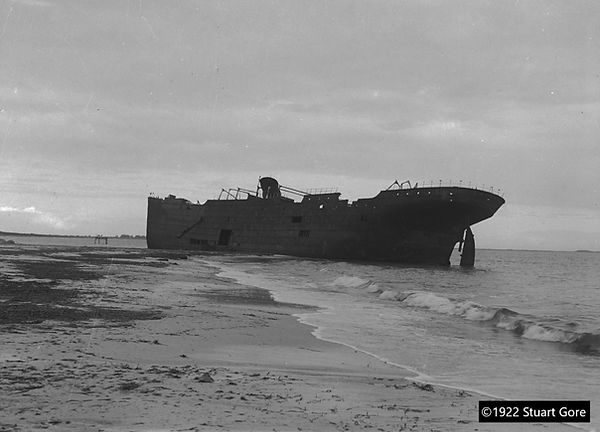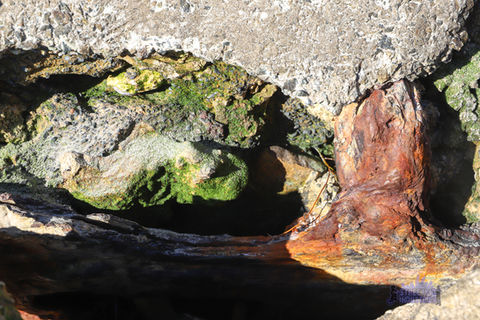SS Kwinana Shipwreck Jetty
In July 1922, a fierce storm broke the moorings of a steamship called the SS Kwinana, sending it drifting across Cockburn Sound. Already damaged by a fire, it washed up on the shore of what is now Kwinana Beach.
At the time, the area was just a quiet stretch of coast near Rockingham. Clara Wells, a local postmistress who ran a small store and post office by the beach, began marking incoming mail bags with the words “Kwinana Wreck,” to distinguish the location from Rockingham. The nickname quickly caught on for the area, although it was officially given the name Kwinana Beach in 1937.
The park at the wreck site was later named Wells Park, in honour of Clara.
The SS Kwinana
William Doxford & Sons Ltd built the SS Dariu, named after Darius the Great of Persia, in 1892 at their shipyard in Sunderland, England. The vessel was fitted with a three-cylinder steam engine and a schooner sail rig, marking the shift between sail and steam power. Commissioned by Archibald Currie & Co. of Melbourne, the Darius was used to transport horses and general cargo between Australia and Calcutta, India.
.jpg)
Shipping Timber for India on the SS Kwinana (1905)
The SS Kwinana
William Doxford & Sons Ltd built the SS Dariu, named after Darius the Great of Persia, in 1892 at their shipyard in Sunderland, England. The vessel was fitted with a three-cylinder steam engine and a schooner sail rig, marking the shift between sail and steam power. Commissioned by Archibald Currie & Co. of Melbourne, the Darius was used to transport horses and general cargo between Australia and Calcutta, India.
In 1912, the Western Australian Government’s State Shipping Service purchased the steamship for £19,000. It was renamed Kwinana, an Aboriginal word meaning “young woman” or “pretty maid.” The vessel was acquired to serve the Western Australian coastline, primarily transporting up to 780 head of cattle and goods from the remote northwest to the south. It was also refitted to carry more passengers, allowing it to operate longer voyages during the quieter cattle seasons, including trips to New Zealand, South Africa, Singapore, and Hong Kong.
During its first decade of service, the Kwinana suffered several mishaps: a coal bunker fire and collision with a submerged rock in 1914, a mechanical breakdown in 1917, a steering failure in 1918, and most seriously, a cargo hold fire on 24 December 1920 caused by spontaneous combustion. The crew battled the blaze at sea and managed to bring it under control, only to see it flare up again on Christmas Day. They diverted the burning ship to Carnarvon, where a salvage tug flooded her decks to extinguish the flames. Although saved from total destruction, the vessel was severely damaged. Returning to Fremantle in early 1921, she was declared beyond economical repair and scheduled for scrapping. While awaiting dismantling in Careening Bay at Garden Island in May 1922, the Kwinana broke free from her moorings during a gale and drifted across Cockburn Sound, beaching herself on the coast that now bears her name.

Building a Jetty on the Hull
As Kwinana Beach grew in popularity as a spot for camping, fishing and picnicking, the community decided to build a proper jetty. A wooden jetty was constructed over the remains of the SS Kwinana in 1937. The ship’s burnt-out hulk had been sitting in the shallow water for years and instead of removing it, it was repurposed. The upper parts of the wreck were cut down, while the hull under the water formed a solid base for the jetty. The outline of the ship’s hull was retained and is still visible today from above.

Kwinana Beach Ocean Pool
In 1941, the old wreck under the jetty was used for an army explosives training exercise, where they blew parts of it up.
After the war, what remained of the ship’s hull was cut down to the waterline and the inside was filled with limestone and concrete, turning the base of the jetty into a more solid walkway.
In the 1960s, the community created an “ocean swimming pool” by the jetty. This sectioned-off swimming area was protected by it, as the jetty acted as a breakwater. Despite the growing number of heavy industries along the Kwinana and Rockingham coastline, the beach and jetty at Wells Park remained a popular location for decades.
Storm Damage and Demolition
The Kwinana Jetty was destroyed in a heavy winter storm in June 2012. Fierce winds and waves battered the coast and the old jetty, which by then was 75 years old. Large sections of the structure were broken and washed away by the rough seas, leaving it in such disrepair, the City of Kwinana were forced to declare it as unsafe and closed it to the public. It remained that way for the next three years.
The broken jetty remained standing in the shallow waters, whilst the community debated its fate. For many locals who had timeless memories, the jetty meant something to them. Despite more than 1,300 people signing a petition in 2015 to save and repair it, engineering inspections showed the damage was too great and nothing could be done to repair it to modern safety standards.
The SS Kwinana Shipwreck jetty was finally demolished mid-2016 (according to Landgate imagery, although other sources report mid-2015).
What Remains
Bits of old concrete and limestone that once filled the ship’s hull can still be seen at low tide. They are the only physical reminders of the old jetty and the shipwreck lying underneath.

.png)































